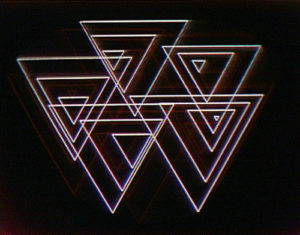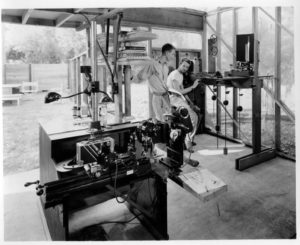When we look at the history of computing and computer-generated models, we tend to think more in the realm of old room-sized computers that perform more science-oriented tasks for the computer scientists and engineers handling these early devices. This idea, however, is far from the reality of early computing. John Whitney, one of the first computer animators and one of the first pioneers in computer-graphics shows an interesting side to the history of animation.

Before computer-graphics, computers were used for more scientific or war-related efforts such as “to break Nazi codes” or to ease “British and American World War II defense efforts.” With the use of computer motion-control, John Whitney was able to produce a wide range of innovative visuals. Between the years 1960 to 1969, John became interested in computer generated films. One example of this interest was titled “Catalog” which was a demo created with a WWII anti-aircraft gun sight. The techniques he used in the development of his demo included geometric patterns and wave-like patterns. The choice of color in some of these images are like those used by companies nowadays such as PlayStation and the early Microsoft startup screen.

Although John Whitney’s early film proposals were rejected, the originality of his film ideas caught the attention of Jack Citron who would later program the computers, with the use of motion graphics, that he would use to make his first film. John’s later films, however, used the idea of Harmonic Progression. He experimented with different arts such as Islamic architecture which would end up as harmonic waveforms which were characterized as reverse curves.

The later part of his career involved developing the actual instruments that allowed the animations to come alive. He began to think more like a computer scientist and he started to show interest in composing visual and musical output. With the fact that most films prior to this were silent, it showed that Whitney was not only an artist but a visionary as well. After working for more than 55 years, his ability to work as both a filmmaker and computer scientist has inspired both individuals and companies. the quality of Whitney’s work when computers were not user-friendly is truly astonishing and it showed the idea that computers can be used as a medium to create art.
John Whitney’s “Catalog” :
If you’re interested in computer-graphics:
https://graphics.stanford.edu/courses/cs248-02/History-of-graphics/History-of-graphics.pdf

Nice job Cesar! Whitney was massively influential in the computer graphics scene. You note that he drew inspiration from mathematical formulas and architecture. What other fields can you draw inspiration from?
It’s really cool how Whitney was one of the first people to actually use computers as a way to produce art – it’s amazing that he even went so far as to add musical output, which is something that you mentioned wasn’t common during the time period. You talked a little bit about his work with Harmonic Progression, and I think it would be interesting to know more about how it influenced his later work.
His work is extremely interesting, it would be cool to see how he got into computer graphics and how he figured it out considering that it was unknown territory. It’s amazing that companies like Playstation and Microsoft studied his work and built upon it. He must have pioneered graphic design and mixing art and technology because like you said, computers functioned as tools for scientists and engineers. It would be interesting to see how much his work influenced others and if he had started a movement with combining technology and art.
It’s amazing that Whitney was able to pioneer such a radically different art form at the time! It would be interesting to know what motivated/influenced him to make the jump from using computer animation for military use to using computer animation for art. You mentioned briefly that his work impacted great companies even nowadays like Playstation, but I wonder what the reaction of this new art form was like during it’s debut.
It’s interesting to me how he was the pioneers of a completely new paraidigm in computing. I wonder how he would use these principles in his work in the TV. I’m curious how exactly he implemented Islamic architecture in his work. Is it the patterns that he was influenced by?
I love how Whitney re-purposed computers that were usually used in war-related coding and scientific coding. I also appreciate how he was one of the first to combine visual art with audio. I feel like audio brings another aspect to the art that you can be creative with. I wonder how and why he decided to add audio output to his artwork?
I think it is amazing that coding was used to express art even during that time. I thought this was a recent thing, but obviously Whitney was able to perform and express his creativity through computer graphics. It is also very interesting that Whitney was called as not only a film maker, but also a computer scientist.
This project is so cool! It’s interesting to think about the history of not just computer programming, but coding as an art form. His work seems to question what a “film” is because as far as I can tell it uses no traditional storytelling forms, but it also calls into question what the purpose of computer programming is by extending it beyond practical choices. I can also clearly see how his design inspired later companies — the shapes and colors look so familiar, even when I had never seen the original before.
I find it very interesting that he used computer coding to do this artistic work at the time he did as much of the computer science world must have been still focusing on other forms of technical work and might not have scene his work as practical at times. I also appreciate this from the perspective of someone going into animation to see the technical side of coding used for these amazing pieces.
This is great Cesar! You’re so right. When I think of the early days of computers I imagine huge rooms full of processors and nothing even semi-related to art. Honestly, before this class, I didn’t really see code as a means of expression either, aside from the tools that people use (i.e. photoshop is programmed to do what it does). When I think about the days of early computing, I imagine one of the big limitations was very low-level languages. Now we have processing, where we are able to abstract most of the work from what the computer actually reads, but I’d be interested to know which languages he used and whether he had to create his own languages since he was a pioneer in this area.
This was definitely interesting to read since first, this was my introduction to John Whitney and his work, and your research shows how he stretched the possibility of computer engineering to a new level. I also really liked how you added a presentation pdf about the history of graphics because it directs us to the next thing that we might want to look at. The fact that Whitney was a computer scientist and a filmmaker was also interesting given the fact that nowadays there are many people who build their careers off of creative computing. It would be an interesting research to look into some examples of the aftermath of Whitney’s work. How did the works of individuals and companies change?
I found your post very interesting how from such an old machine he was able to create such complex images. I also find how him using computers as a means of expression was also able to advance the field. I found the comparison to computers using math to generate art and humans using their minds very interesting. His films seemed very dark but that may just be because of the outdated system he used.